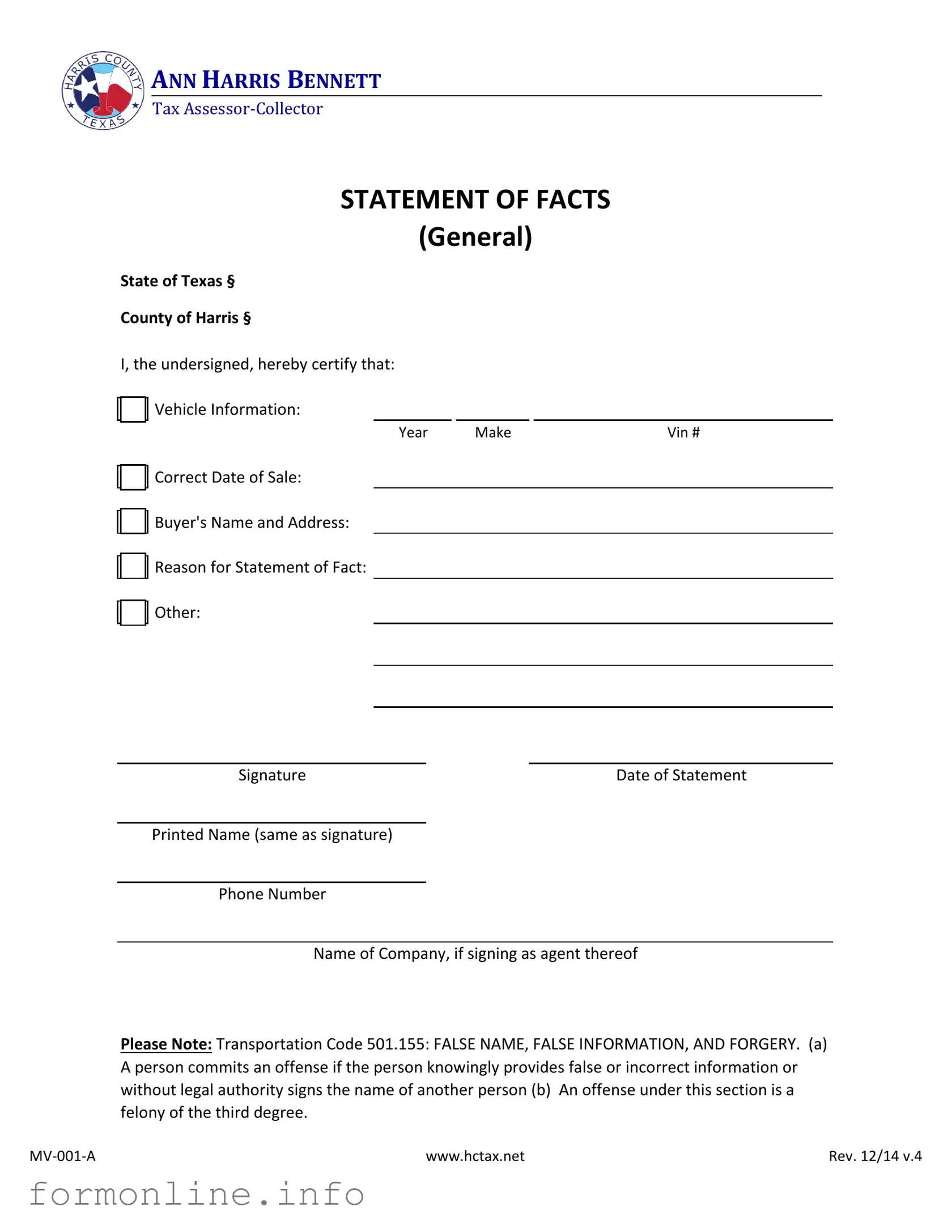The Affidavit of Fact serves a similar purpose to the Statement of Fact Texas form by providing a sworn statement that outlines specific facts regarding a situation or transaction. Like the Statement of Fact, it requires detailed information about the subject matter, such as vehicle details or personal identification. The key difference lies in the legal weight; an affidavit is sworn before a notary public, making it a more formal declaration that can be used in court proceedings.
The Bill of Sale is another document that shares similarities with the Statement of Fact. Both forms require details about the transaction, including the buyer's and seller's information, as well as specifics about the item being sold, such as a vehicle. However, the Bill of Sale serves as proof of ownership transfer, while the Statement of Fact may address reasons for discrepancies or clarifications without necessarily transferring ownership.
The Vehicle Registration Application is closely related, as it also involves vehicle details and ownership information. Both documents require accurate data to ensure legal compliance. However, the Vehicle Registration Application is primarily used to register a vehicle with the state, while the Statement of Fact may be used to clarify or correct information related to the vehicle's title or history.
The Power of Attorney form is similar in that it allows one person to act on behalf of another. Both documents require the identification of the parties involved and may involve vehicle transactions. However, the Power of Attorney grants legal authority to act, whereas the Statement of Fact is more about affirming specific facts without transferring authority.
The Certificate of Title is another relevant document, as it also contains essential information about a vehicle, including its ownership and history. While the Statement of Fact may be used to clarify or correct information related to the title, the Certificate of Title itself serves as the official document proving ownership and is required for legal vehicle transactions.
The Declaration of Ownership is akin to the Statement of Fact in that it asserts ownership of a vehicle or property. Both documents require the owner’s information and details about the item in question. The Declaration of Ownership may be used in situations where proof of ownership is needed, while the Statement of Fact may clarify discrepancies or provide additional context regarding the ownership status.
The Notice of Transfer and Release of Liability is similar in that it addresses the transfer of ownership of a vehicle. Both documents require information about the buyer and seller, as well as the vehicle details. However, the Notice of Transfer and Release of Liability is specifically used to inform the state of the change in ownership, while the Statement of Fact may be used to explain issues or corrections related to the transfer.
The Odometer Disclosure Statement is relevant as it requires disclosure of the vehicle's mileage during a sale. Both documents focus on vehicle information and require accurate reporting. However, the Odometer Disclosure Statement is specifically aimed at preventing fraud related to odometer readings, while the Statement of Fact may address broader issues or corrections regarding the vehicle's title or ownership history.
When dealing with shipping documents, it's essential to understand the significance of the FedEx Bill of Lading form, which is pivotal in outlining the details of a freight shipment. This form not only establishes the carrier's responsibility for the goods but also captures vital information about both the shipper and the recipient. For further guidance on the intricacies involved in shipping paperwork, consider checking Top Forms Online, where you can find more resources related to handling these important documents.
Finally, the Application for Duplicate Title serves a similar function in that it deals with vehicle titles. Both documents require information about the vehicle and its owner. However, the Application for Duplicate Title is specifically used when a title has been lost or damaged, while the Statement of Fact may be used to clarify or correct existing title information without the need for a duplicate.

